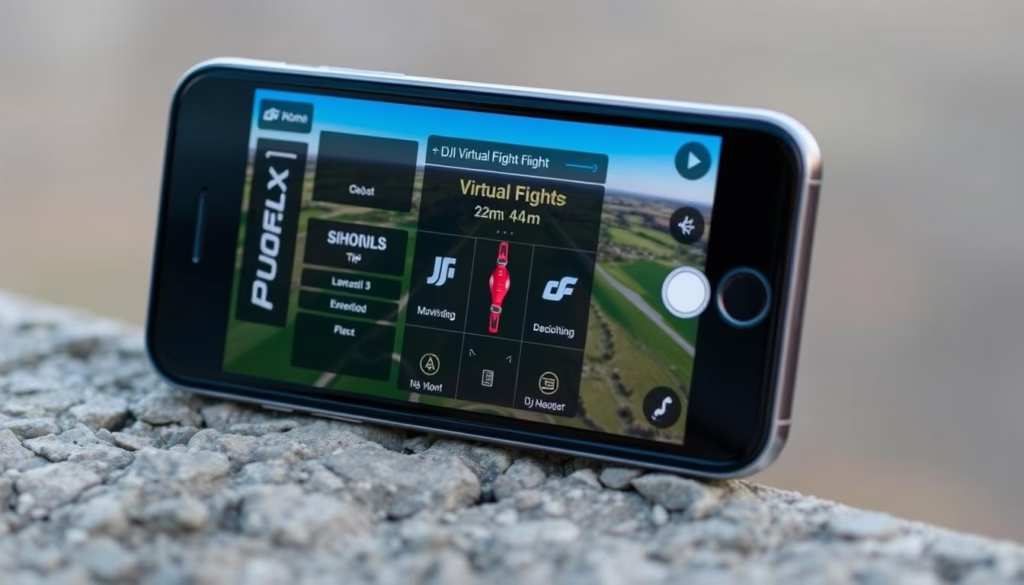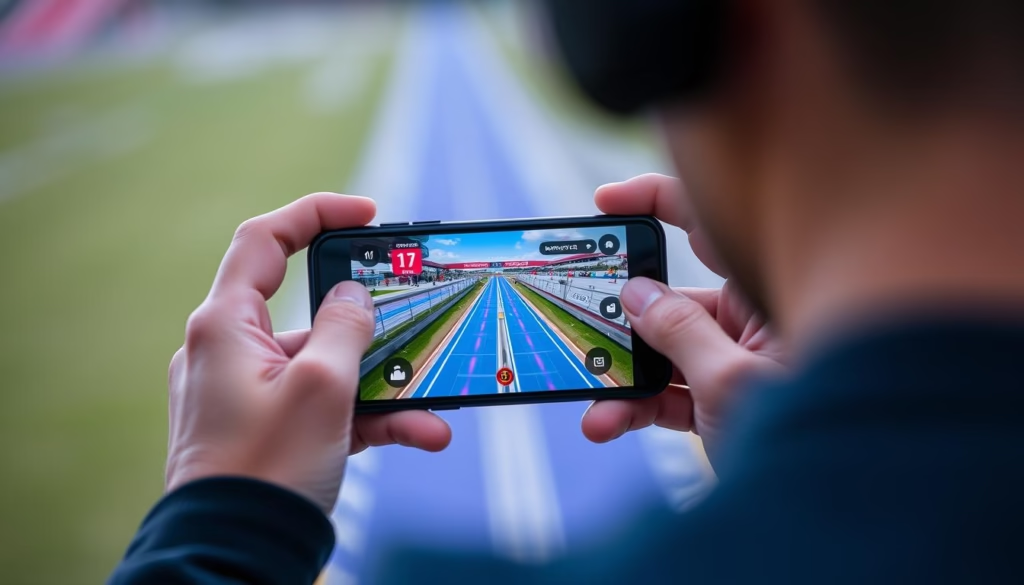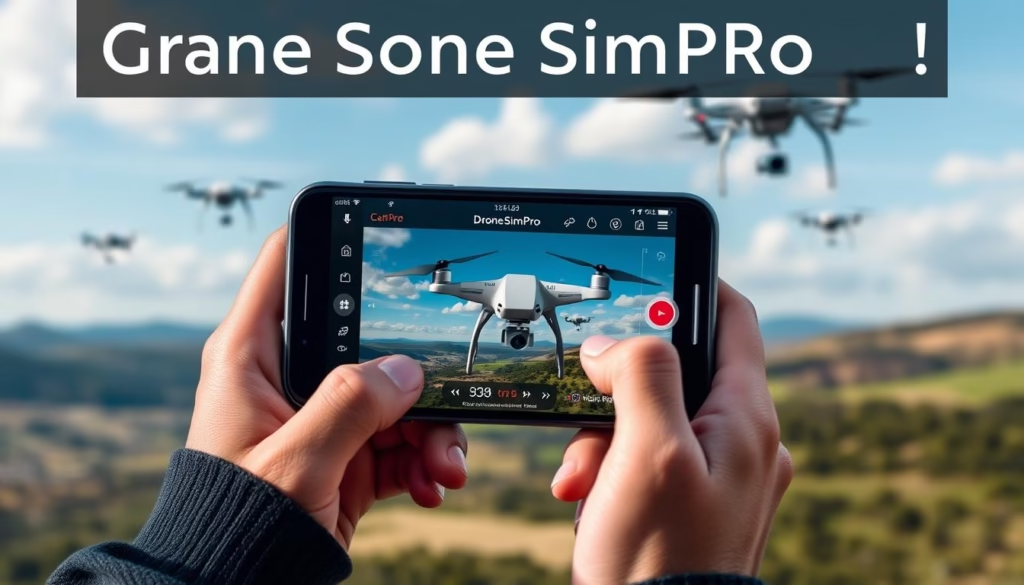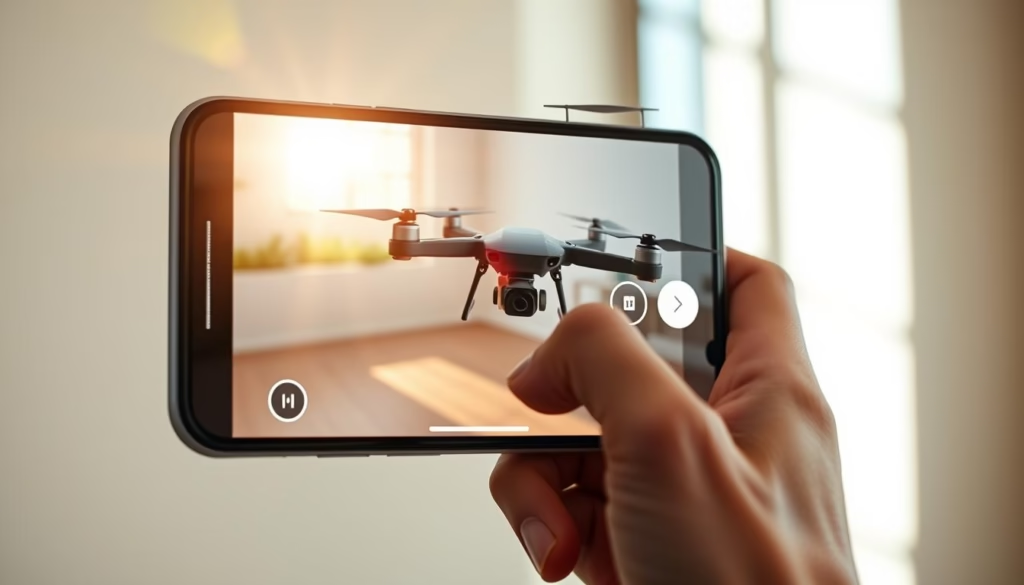Are you eager to master drone flying but hesitant due to safety concerns or lack of experience? We have the perfect solution for you. Our iPhone drone simulator offers a risk-free environment to hone your skills before taking to the skies.
With realistic physics-based flying experiences and customizable controls, our simulator provides an immersive way to become a skilled drone pilot. You can practice FPV flying and master various techniques without the fear of crashing expensive equipment.
Key Takeaways
- Practice drone flying techniques in a risk-free virtual environment.
- Experience realistic flight physics and responsive controls.
- Try different drone models and flight characteristics.
- Develop crucial muscle memory and reflexes for real-world flying.
- Reduce the learning curve when transitioning to actual drone operation.
Why iPhone Drone Simulators Are Essential for Pilots
iPhone drone simulators have become a crucial tool for pilots looking to hone their skills without the risk of damaging actual drones. These simulators provide a realistic and immersive experience, allowing users to develop their flying skills in a controlled environment.
Safety Benefits of Virtual Training
One of the primary advantages of using an iPhone drone simulator is the safety it offers. Pilots can practice complex maneuvers and learn from mistakes without causing damage to their equipment or posing a risk to others. This virtual training environment is particularly beneficial for beginners, as it allows them to build confidence and improve their skills without the fear of crashing or causing accidents.
The safety benefits of virtual training also extend to the reduction of risk associated with flying in various environments. Pilots can simulate flights in different weather conditions, locations, and scenarios, preparing them for real-world challenges.
Cost-Effective Skill Development
iPhone drone simulators are not only safe but also cost-effective. Compared to purchasing and maintaining physical drones, simulator apps offer a fraction of the cost. Users can explore different drone models and practice flying without the financial burden of replacing damaged equipment.
| Cost Factor | Physical Drone | iPhone Drone Simulator |
|---|---|---|
| Initial Investment | High | Low |
| Maintenance and Repair | Ongoing | Minimal |
| Upgrade Options | Limited | Regular Updates |
By utilizing an iPhone simulator, pilots can develop skills that are directly transferable to real-world flying, maximizing their return on investment when they eventually purchase a physical drone.
How iPhone Drone Simulator Apps Improve Your Flying Skills
The rise of iPhone drone simulators has transformed drone training by allowing pilots to practice complex maneuvers risk-free. By honing their skills in a virtual setting, pilots can improve their understanding of drone controls, reaction timing, and advanced maneuvers before taking their drones to the skies.
Building Muscle Memory Without Consequences
iPhone drone simulators provide a risk-free environment to practice advanced techniques like flips, rolls, and precision hovering. The ability to attempt challenging maneuvers without fear of crashes accelerates the learning curve for complex flight techniques. Simulators allow pilots to break down advanced movements into component parts, mastering each element before combining them into complete maneuvers.
| Skill Developed | Simulator Benefit |
|---|---|
| Muscle Memory | Practice without consequences |
| Advanced Maneuvers | Break down complex movements |
| Reaction Timing | Improve reaction time in a virtual environment |
Mastering Advanced Maneuvers Safely
Virtual environments can be configured with various obstacles and challenges specifically designed to develop advanced flying skills. The instant reset capability after failed attempts encourages experimentation and pushing boundaries that would be impractical with physical drones. Many simulators include specific training modules focused on particular advanced techniques, providing structured learning paths for skill development.
By mastering advanced maneuvers in a simulator, pilots gain confidence that translates directly to greater control and precision when flying physical drones. This confidence is crucial for FPV drone pilots who need to navigate complex courses with precision.
Key Features to Look for in an iPhone Drone Simulator
When selecting an iPhone drone simulator, several key features can significantly enhance your training experience. A comprehensive simulator should offer a combination of realistic flight physics, customizable controls, and diverse training environments to prepare you for various real-world scenarios.
Realistic Flight Physics
A simulator with realistic flight physics is essential for developing the skills needed for actual drone flying. It should accurately model the behavior of different drone models, including their aerodynamics and response to control inputs. This realism helps you understand how your drone will behave in different conditions, making your training more effective.
Customizable Controls and Settings
Customizable controls and settings allow you to tailor the simulator to your learning needs. Look for simulators that let you adjust sensitivity, control layout, and other parameters to match your preferences. This flexibility ensures that you can practice with settings that closely mimic your actual drone’s behavior.
Variety of Training Environments
Practicing in a variety of training environments is crucial for becoming a well-rounded drone pilot. A good simulator should offer diverse scenarios, including open fields, urban landscapes, forests, and challenging terrains. The ability to adjust weather conditions, time of day, and other environmental factors further enhances the realism and prepares you for a wide range of real-world flying scenarios.

DJI Virtual Flight: Professional-Grade Simulation

For those seeking a premium drone simulation experience, DJI Virtual Flight stands out. This professional-grade simulator is designed to provide a comprehensive training experience for drone pilots.
Overview
DJI Virtual Flight includes a range of features designed to provide a comprehensive training experience. These include accurate drone models, realistic physics, various environments, and training scenarios. The app also supports connection with physical DJI controllers for an authentic experience.
Pros
The DJI Virtual Flight simulator offers several benefits, including:
- Meticulously detailed 3D models of DJI’s entire drone lineup with authentic flight characteristics.
- DJI’s complete intelligent flight mode suite, allowing users to practice with features like ActiveTrack and Waypoints.
- Realistic camera simulation replicating actual camera settings and gimbal behavior.
Cons
While DJI Virtual Flight is a powerful tool, it may have some limitations, such as:
- Requires a compatible DJI controller for full functionality.
- May have a steep learning curve for beginners.
Features
The DJI Virtual Flight app boasts an impressive feature set, including:
- Multiple training environments, ranging from open fields to urban landscapes.
- Comprehensive tutorial modules providing structured learning paths.
- Realistic weather effects and environmental conditions impacting flight performance.
- Performance analytics tracking progress over time.
- Support for FPV (First-Person View) flying experiences.
By offering a realistic and immersive drone simulator experience, DJI Virtual Flight helps pilots develop their skills in a safe and controlled environment.
Aerofly FPV: Master Drone Racing Virtually

With Aerofly FPV, you can master drone racing virtually, leveraging its advanced features for a realistic experience. This simulator app is designed specifically for drone racing enthusiasts, offering a comprehensive training platform on your iPhone.
Overview
Aerofly FPV is a sophisticated drone simulator that replicates the excitement of drone racing. It includes realistic racing physics, customizable drone parameters, and various racing tracks, making it an ideal tool for improving your racing skills.
Pros
- Realistic Flight Experience: The app offers realistic flight physics, making your virtual racing experience as close to real as possible.
- Customizable: You can customize drone parameters and racing tracks to suit your skill level and preferences.
Cons
- Limited Real Drone Compatibility: While it’s great for simulation, some users might find its compatibility with real drones limited.
- Resource-Intensive: The app can be demanding on your iPhone’s resources, potentially affecting performance.
Features
- A comprehensive track editor to design and share custom racing courses.
- Multiple racing drone models with different performance characteristics.
- Advanced telemetry displays for real-time feedback on drone performance.
- Various camera views, including first-person FPV, chase cam, and spectator perspectives.
- Realistic sound design to replicate the audio feedback of racing drones.
- Time trial modes, ghost racing, and multiplayer capabilities.
- Customizable weather and lighting conditions to practice racing in challenging visibility.
By utilizing Aerofly FPV, you can significantly improve your drone racing skills in a risk-free environment. Whether you’re a beginner or an experienced pilot, this simulator app has the features you need to take your racing to the next level.
DroneSimPro: Industry-Focused Training

DroneSimPro is a cutting-edge iPhone app designed for industry-focused drone training. This advanced drone simulator offers a realistic and comprehensive training experience, tailored to the needs of professionals in various industries.
Overview
DroneSimPro includes a range of features designed for professional drone applications, such as accurate simulations of commercial drone models, industry-specific training scenarios, and advanced camera controls. The app is aligned with commercial drone certification requirements, making it an ideal tool for professionals seeking to enhance their skills.
Pros
The pros of using DroneSimPro include its realistic flight simulations, comprehensive training modules, and advanced mission planning tools. These features enable users to practice complex fpv (first-person view) flight operations, including automated surveys and precision mapping.
Cons
While DroneSimPro offers numerous benefits, some users may find the app’s extensive features overwhelming at first. However, the intuitive interface and comprehensive tutorials help mitigate this issue.
Features
- Detailed simulations of professional-grade drone platforms with accurate flight characteristics and control systems.
- Industry-specific training modules for sectors like construction, agriculture, and public safety.
- Advanced mission planning tools for practicing complex flight operations.
- Realistic camera and sensor simulations for data collection in commercial drone operations.
- Comprehensive weather and environmental effects to simulate challenging conditions.
- Training scenarios designed to develop precise control required for commercial applications.
- Detailed analytics and performance tracking to identify areas for improvement.
By utilizing DroneSimPro, professionals can significantly enhance their drone flying skills and prepare for real-world challenges. The app’s focus on industry-specific training makes it an invaluable tool for those seeking to excel in their respective fields.
Best iPhone Drone Simulator Apps for Beginners
Beginners can significantly benefit from using iPhone drone simulators that offer guided learning experiences. These simulators provide a risk-free environment where new pilots can develop their skills systematically.
User-Friendly Interfaces
The best beginner-focused iPhone drone simulators feature user-friendly interfaces that make it easy for new users to navigate and understand the simulator’s functions. These interfaces often include intuitive controls and clear instructions that help beginners get started quickly.
By providing a simple and straightforward user experience, these simulators enable new pilots to focus on developing their flying skills without being overwhelmed by complex menus or settings.
Guided Learning Experiences
Guided learning experiences are a crucial feature of beginner-friendly drone simulators. These experiences typically include step-by-step tutorials, skill-building exercises, and progressive challenges that help new pilots build confidence and competence over time.
- Structured learning paths that introduce fundamental skills in a logical progression
- Mission-based tutorials that transform learning objectives into engaging challenges
- Immediate feedback systems that help beginners understand their performance
- Achievement systems and progress tracking that provide motivation and indicators of skill development
By incorporating these features, the best iPhone drone simulators for beginners provide a comprehensive learning experience that helps new pilots develop their skills and become proficient drone operators.
How to Choose the Right iPhone Drone Simulator for Your Needs
To maximize your drone flying skills, it’s essential to choose an iPhone drone simulator that aligns with your goals and experience level. The right simulator can help you improve your flying techniques, prepare for complex maneuvers, and reduce the risk of accidents.
Assessing Your Skill Level
Begin by evaluating your current skill level. Are you a beginner looking for a user-friendly interface, or an experienced pilot seeking advanced features? Understanding your skill level will help you narrow down the options to simulators that cater to your needs.
Matching Simulator Features to Your Goals
Next, consider the features that are important to you. Do you need realistic flight physics, customizable controls, or a variety of training environments? Matching the simulator’s features to your goals will ensure that you’re getting the most out of your training.
Budget Considerations
Drone simulator apps can range from free to premium subscription-based models. Consider your budget and the features you need. Mid-range simulators often offer the best value, balancing comprehensive features with reasonable one-time purchase costs. Many quality simulators offer free trials, allowing you to test compatibility and features before committing.
Maximizing Your Learning with Drone Simulators
Maximizing your learning with a drone simulator requires a strategic approach to practice. To truly benefit from iPhone drone simulator training, you need to practice regularly and with purpose. By doing so, you can develop skills that translate to real-world flying scenarios.
Establishing an Effective Practice Routine
To get the most out of your simulator practice, establish a consistent routine. Set aside dedicated time to practice FPV flying or other specific skills. Effective practice involves setting clear, measurable goals for each session, allowing you to stay focused and motivated.
Tracking Your Progress and Setting Goals
Tracking your progress is crucial to improving your drone flying skills. Use the simulator’s built-in metrics or maintain a personal training log to document your performance. Set SMART (Specific, Measurable, Achievable, Relevant, Time-bound) goals for your simulator practice to provide clear direction and motivation. Break larger objectives into smaller milestone goals, and use the simulator’s replay features to review your performance and identify areas for refinement.

Transitioning from Simulator to Real Drone Flying
While drone simulators provide excellent training, the real test of your skills comes when you fly a real drone. As you transition from virtual to real-world flying, you’ll encounter new challenges that require adaptability and skill.
Applying Virtual Skills to Real-World Scenarios
The skills you’ve honed in a drone simulator are valuable, but applying them to real-world scenarios demands more than just proficiency in virtual flight. You must adapt to the genuine consequences and stakes of physical flight, where factors like wind gusts, changing light conditions, and variable temperatures affect your drone in nuanced ways.
Common Adjustment Challenges
Several challenges arise when transitioning from a simulator to a real drone. Many pilots experience heightened anxiety during initial real flights despite their simulator proficiency. Environmental factors, sensory experiences, and the need for battery management create new challenges. Additionally, the weight and inertia of physical drones often feel different than their virtual counterparts, requiring subtle adjustments to control inputs.
- Adapting to the genuine consequences and stakes of physical flight.
- Heightened anxiety during initial real flights.
- Environmental factors like wind gusts and changing light conditions.
- Differences in sensory experience between virtual and real flying.
By understanding these challenges and maintaining a balance between simulator practice and hands-on experience, you can ensure a smoother transition to flying real drones and become a proficient pilot in real-world flight scenarios.
Understanding Drone Regulations Through Simulation
Understanding drone regulations is crucial for safe and responsible flying. Drone simulators provide an ideal platform for learning these regulations, allowing pilots to practice and understand the rules of the sky without any real-world risks.
Learning Airspace Restrictions Virtually
One of the key benefits of using a drone simulator is the ability to learn about airspace restrictions in a virtual environment. Simulators can recreate various airspace scenarios, helping pilots understand where they can and cannot fly. This includes restricted areas around airports, national parks, and other sensitive locations.
By practicing in a simulator, pilots can develop a better understanding of these restrictions and avoid potential fines or penalties. The simulator environment allows for the exploration of different scenarios, enhancing a pilot’s ability to navigate complex airspace.
| Airspace Type | Description | Restrictions |
|---|---|---|
| Class G | Uncontrolled airspace | Visual Line of Sight (VLOS) only |
| Class E | Controlled airspace extending upward from a specified altitude | Requires clearance for drone operations |
| Class B, C, D | Controlled airspace around airports | Requires specific authorization and clearance |
Practicing Responsible Drone Operation
Drone simulators also enable pilots to practice responsible drone operation, including respecting privacy and minimizing disturbance to wildlife. Simulators can recreate scenarios that test a pilot’s judgment, such as flying near populated areas or sensitive ecosystems.
By practicing these scenarios, pilots can develop the ethical decision-making skills necessary for responsible drone operation. This includes understanding appropriate distances from people, properties, and sensitive locations, as well as being aware of the acoustic footprint of their drone.
Conclusion: Take Flight Risk-Free with iPhone Drone Simulators
iPhone drone simulators offer a risk-free environment for pilots to hone their skills, regardless of their experience level. These powerful training tools provide a comprehensive foundation of muscle memory, spatial awareness, and control familiarity that transfers directly to real-world flying.
By leveraging iPhone drone simulators, you can accelerate your learning process, build confidence, and refine your piloting skills without the financial investment of physical equipment. Whether you’re a beginner or an experienced pilot, these simulators offer the perfect balance of accessibility, effectiveness, and convenience.
As you embark on your drone journey, we encourage you to explore the world of iPhone drone simulators and discover the benefits of risk-free training. With the right simulator, you can develop the skills and confidence needed to excel in the world of drone piloting.
FAQ
What are the benefits of using an FPV drone simulator?
Using an FPV drone simulator allows you to practice flying without risking damage to your drone, helping you develop skills and build muscle memory in a safe environment.
Can I use an iPhone drone simulator to learn how to fly a DJI drone?
Yes, many iPhone drone simulators, including DJI Virtual Flight, offer realistic simulations of DJI drones, allowing you to practice flying and learn the characteristics of different models.
How realistic are drone simulators?
Modern drone simulators, such as Aerofly FPV, offer realistic flight physics and environments, making them an effective tool for training and improving your flying skills.
What features should I look for in a drone simulator app?
When choosing a drone simulator app, look for features like customizable controls, realistic flight physics, and a variety of training environments to help you improve your skills.
Can drone simulators help me prepare for drone racing?
Yes, drone simulators like Aerofly FPV are designed to help you master drone racing virtually, with realistic tracks and challenging courses to test your skills.
Are drone simulators suitable for beginners?
Yes, many drone simulators, including DroneSimPro, offer user-friendly interfaces and guided learning experiences, making them a great tool for beginners to learn the basics of drone flying.
How can I maximize my learning with a drone simulator?
To get the most out of a drone simulator, establish a regular practice routine, track your progress, and set goals for improvement to help you stay motivated and focused.
Can I transfer my skills from a simulator to real-world drone flying?
Yes, by practicing with a drone simulator, you can develop the skills and muscle memory needed to fly a real drone confidently and effectively.



